
The Dakar Rally or simply "The Dakar", formerly known as the "Paris–Dakar Rally", is an annual rally raid organised by the Amaury Sport Organisation. Most events since the inception in 1978 were staged from Paris, France, to Dakar, Senegal. Security threats in Mauritania led to the cancellation of the 2008 rally, and events from 2009 to 2019 were held in South America. Since 2020, the rally has been held in Saudi Arabia. The event is open to amateur and professional entries, professionals typically making up about eighty percent of the participants.
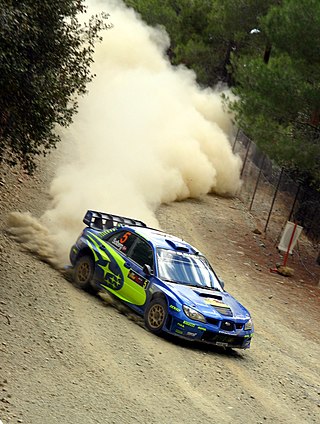
Rallying is a wide-ranging form of motorsport with various competitive motoring elements such as speed tests, navigation tests, or the ability to reach waypoints or a destination at a prescribed time or average speed. Rallies may be short in the form of trials at a single venue, or several thousand miles long in an extreme endurance rally.

Baja California Sur, officially Estado Libre y Soberano de Baja California Sur, is the least populated state and the 31st admitted state of the 32 federal entities which comprise the 31 States of Mexico. It is also the ninth-largest Mexican state in terms of area.
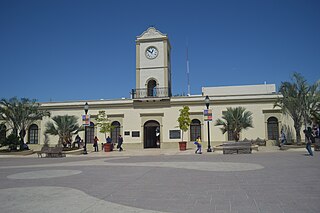
San José del Cabo is a coastal city located on the Gulf of California coast, near the southern tip of Baja California Sur (state), México. San José del Cabo is situated on the edge of a shallow bay, some 32 kilometres (20 mi) northeast of Cabo San Lucas, a city with which it shares the title of Los Cabos.

Gumball 3000 is a brand known for the annual Gumball 3000 Rally, an international celebrity motor rally that takes place on public roads. The brand was founded in 1999 by British entrepreneur Maximillion Cooper, with his vision to combine cars, music, fashion and popular culture.

Los Cabos is a municipality located at the southern tip of Mexico's Baja California Peninsula, in the state of Baja California Sur. It encompasses the two towns of Cabo San Lucas and San José del Cabo linked by a thirty-two-km Resort Corridor of beach-front properties and championship golf courses.
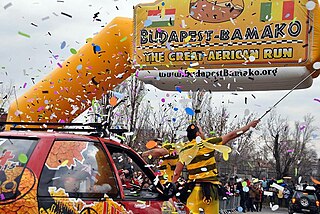
The Budapest-Bamako or Great African Run is a charity car race in Africa, and the largest amateur rally in the world. It is a low-budget version of the Dakar Rally, and goes from Budapest, Hungary to Bamako, Mali through the Sahara. It passes through Hungary, Austria or Slovenia, Italy, France, Spain, Morocco, Mauritania and Mali. The Budapest-Bamako was inspired by the Paris-Dakar Rally. There are few entry restrictions: as long as a vehicle is street legal, it can join the event.

Enduro is a form of motorcycle sport run on extended cross-country, off-road courses. Enduro consists of many different obstacles and challenges. The main type of enduro event, and the format to which the World Enduro Championship is run, is a time-card enduro, whereby a number of stages are raced in a time trial against the clock.
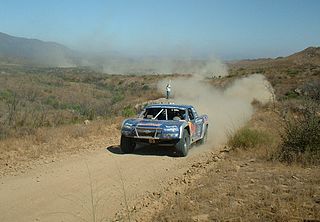
Desert racing is the act of racing through the desert in a two- or four-wheeled off-road vehicle. Races, which generally consist of two or more loops around a course covering up to 4,660 miles (7,500 km), can take the form of Hare and Hound or Hare scramble style events, and are often laid out over a long and harsh track through relatively barren terrain.
The Indian Autorickshaw Challenge is an international autorickshaw rally. The entrants use the autorickshaw or tuk-tuk, a common vehicle of India's urban east, to cross large portions of the Indian sub-continent over a period several of days. The simple construction of the autorickshaw and the diversity of the landscape requires the participants to be resourceful and determined in order to finish the course. The event is organised by Chennai Event Management Services.
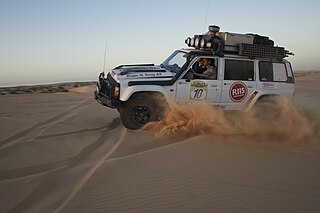
Rally raid is a type of off-road motorsport event for automobiles and motorcycles. Along with shorter baja rallies, rally raid constitutes cross-country rallying. Both the Fédération Internationale de l'Automobile (FIA) and Fédération Internationale de Motocyclisme (FIM) co-organise a common World Rally-Raid Championship featuring the same events for both types of vehicle.

Hurricane Otis was a moderate Category 2 hurricane that threatened the Baja California Peninsula but dissipated before landfall. Otis was the fifteenth and final named storm and seventh hurricane of the 2005 Pacific hurricane season. The storm developed on September 28, 2005, off the western coast of Mexico, from a tropical wave that emerged from the western coast of Africa and traversed the Atlantic Ocean during the preceding several weeks. After attaining tropical storm status on September 29, Otis moved in a generally northwestward direction for most of its duration. It ultimately peaked at Category 2 intensity on the Saffir–Simpson Hurricane Scale before beginning to weaken. The storm degenerated into a tropical depression on October 3 and dissipated fully on October 5, near the coast of Baja California Sur. Preparations for Otis were completed on the Peninsula; tropical cyclone watches and warnings were declared and numerous shelters opened. However, the storm's effects were minimal, and limited to gusty winds with heavy rainfall. No major damage was reported.

Hurricane Jimena is tied with Hurricane Norbert as the strongest tropical cyclone to make landfall on western portion of the Baja California Peninsula. Jimena was the twelfth named storm, fifth hurricane, third major hurricane and overall second-strongest tropical cyclone of the 2009 Pacific hurricane season. Forming from a tropical wave late on August 28, 2009, off of Mexico's Pacific coast, the system rapidly intensified into a Category 2 hurricane on the next day. Two days after developing, Jimena strengthened into a Category 4 hurricane. After peaking close to Category 5 intensity on September 1, it encountered cold water and began to weaken. When the hurricane made landfall on the Baja California Peninsula on September 3, it was only a Category 2 hurricane. On the next day, the tropical cyclone entered the Gulf of California, though the storm weakened into a remnant low after looping back eastward towards Baja California. The storm's remnants drifted westward into the Pacific afterward, before dissipating on September 8.
The National Off-Road Racing Association is a desert off-road racing association.
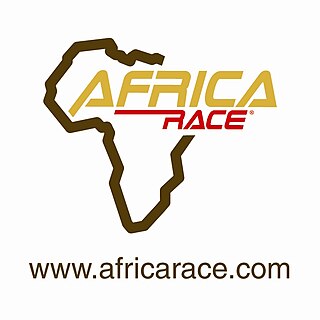
Africa Eco Race is an annual rally raid, organised in France and run in North and West Africa, launched after the cancellation of 2008 Dakar Rally, and the subsequent moving of the rally to South America.

Hurricane Odile is tied for the most intense landfalling tropical cyclone in the Baja California Peninsula during the satellite era. Sweeping across the peninsula in September 2014, Odile inflicted widespread damage, particularly in the state of Baja California Sur, in addition to causing lesser impacts on the Mexican mainland and Southwestern United States. The precursor to Odile developed into a tropical depression south of Mexico on September 10 and quickly reached tropical storm strength. After meandering for several days, Odile began to track northwestward, intensifying to hurricane status before rapidly reaching its Category 4 hurricane peak intensity on September 14. The cyclone slightly weakened before making landfall near Cabo San Lucas with winds of 125 mph (205 km/h). Odile gradually weakened as it tracked across the length of the Baja California Peninsula, briefly crossing into the Gulf of California before degenerating into a remnant system on September 17. These remnants tracked northeastward across the Southwestern United States before they were no longer identifiable on September 19.

The Baja 4000 is a biennial off-road charity rally and road trip organized by the creators of the largest amateur rally in the world, the Budapest-Bamako. It's a low budget, amateur version of the famous Baja 1000 and Dakar Rally. The first edition was held in January 2017. The rally started in Los Angeles and traveled 4000 kilometers on the Baja California peninsula in Mexico. In 2018 before the second edition of the event organizers changed the event's name to Baja XL.

The 2019 Rally Mexico was a motor racing event for rally cars that was held over four days between 7 and 10 March 2019. It marked the sixteenth running of Rally Mexico and was the third round of the 2019 World Rally Championship, World Rally Championship-2 and the newly created WRC-2 Pro class. The 2019 event was based in the town of León in Guanajuato and consisted of twenty-one special stages. The rally covered a total competitive distance of 316.51 km (196.67 mi).
The 2019 FIA World Cup for Cross-Country Rallies was the 27th season of the FIA World Cup for Cross-Country Rallies; an annual competition for rally raid events for cars, buggies, side-by-sides, and trucks held in multiple countries.

Hurricane Lorena was a strong Pacific hurricane in September 2019 that brought heavy rainfall, flooding, and mudslides to Southwestern Mexico and the Baja California Peninsula and also brought severe weather to the U.S. state of Arizona. Lorena was the thirteenth named storm and seventh and final hurricane of the 2019 Pacific hurricane season. A tropical wave, originally from the North Atlantic, entered the East Pacific basin on September 16. With increasing thunderstorm development, Lorena formed as a tropical storm on September 17 alongside Tropical Storm Mario. Lorena made its passage northwestward and quickly gained strength before it made landfall as a Category 1 hurricane in Jalisco on September 19. Due to interaction with the mountainous terrain, Lorena weakened back to a tropical storm. After moving into the warm ocean temperatures of the Gulf of California, however, Lorena re-strengthened into a hurricane, and reached its peak intensity with 1-minute sustained winds of 85 mph (137 km/h) and a minimum barometric pressure of 985 millibars (29.1 inHg) Lorena made a second landfall in the Mexican state of Baja California Sur, and quickly weakened thereafter. Lorena weakened to a tropical storm over the Gulf of California, and became a remnant low on September 22, shortly after making landfall in Sonora as a tropical depression. The remnant low moved inland over Mexico, and eventually dissipated inland over Arizona on September 24.
















